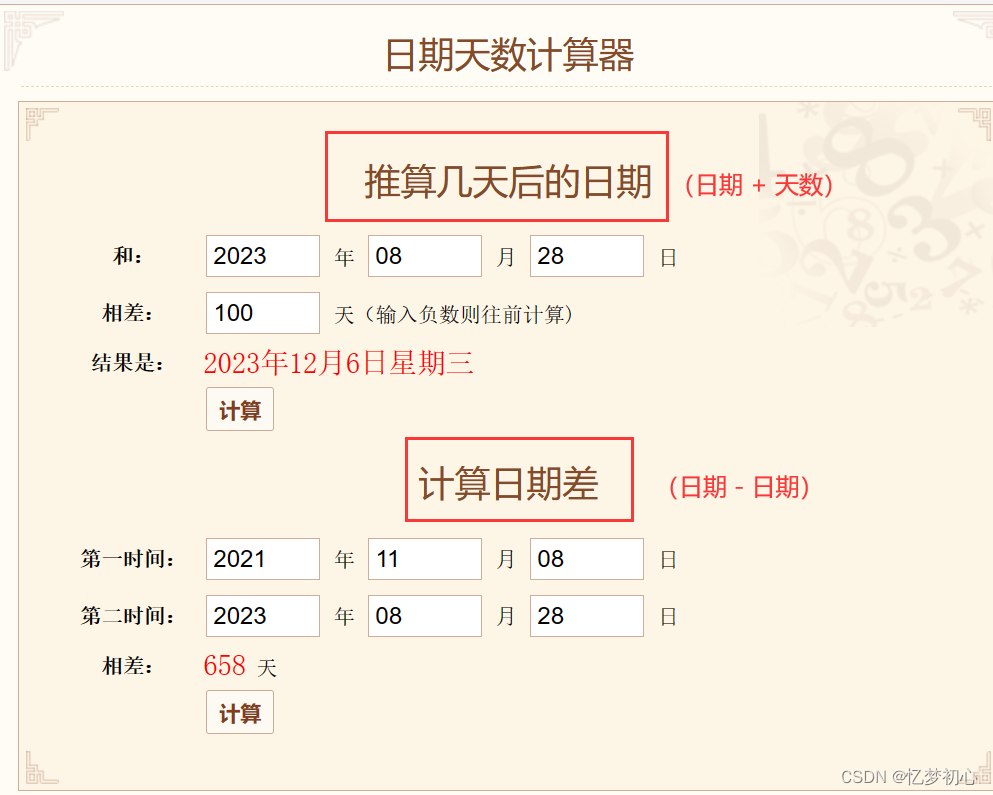目录
一. 前言
通过前面两期类和对象的学习,我们已经对C++的类有了一定的了解。本期我们的目标是实现一个完整的日期类,通过实现日期类的构造函数、运算符重载等等内容,加深对前面知识的理解。
实现了日期类之后,我们就相当于自己实现了一个网上的日期计算器,如下所示![]()

上面的两项功能,都是通过我们接下来要进行的运算符重载实现的。
二. 日期类的框架
以下是我们本期实现的日期类的基本框架![]()
class Date
{
public:
// 全缺省的构造函数
Date(int year = 2023, int month = 1, int day = 1);
// 拷贝构造函数
Date(const Date& d);
// 赋值运算符重载
Date& operator=(const Date& d);
// 析构函数
~Date() {};
// +、=等算数运算符重载
Date& operator+=(int day); //日期+=天数
Date operator+(int day); //日期+天数
Date& operator-=(int day); //日期-=天数
Date operator-(int day); //日期-天数
// 日期-日期 返回天数,即日期差
int operator-(const Date& d);
// 自增、自减运算符重载
Date& operator++(); //前置++
Date operator++(int); //后置++
Date operator--(int); //后置--
Date& operator--(); //前置--
// >、<、==等关系运算符重载
bool operator>(const Date& d);
bool operator==(const Date& d);
bool operator >= (const Date& d);
bool operator < (const Date& d);
bool operator <= (const Date& d);
bool operator != (const Date& d);
//打印数据
void Print();
private:
int _year; //年
int _month; //月
int _day; //日
};三. 日期类的实现
3.1 构造函数
构造函数的目的是初始化类对象,这里我们只需要实现两种构造函数即可。一种是全缺省的构造函数,使用全缺省的构造函数可以让类对象构造时传参更加灵活;而另一种则是拷贝构造函数。
全缺省的构造函数
很简单,我们只需要判断传入的参数是否符合生活中日期的规则,如果符合则正常进行初始化,反之则程序退出。规则大致如下![]()
日期规则
1、月份必须在1月到12月之间。例如0月和13月是非法的
2、日份必须在当前月的天数范围内。例如1月32日,4月31日是非法的
由于每个月的天数不同,尤其是2月,还有闰年平年之分,故我们可以先写个函数用来获取当前月的天数。这个函数不仅可以用在日份的判断,在之后也会经常用到。
// 获取某年某月的天数
int GetMonthDay(int year, int month)
{
//用一个数组表示平年每月的天数,下标表示月份
int MouthDayArray[13] = { 0,31,28,31,30,31,30,31,31,30,31,30,31 };
if (month == 2 &&(year % 4 == 0 && year % 100 != 0) || (year % 400 == 0)) //判断闰年
{
MouthDayArray[2]++; //是闰年,2月份天数+1
}
return MouthDayArray[month]; //返回当前月天数
} 有了上面的函数, 再根据之前的规则,我们很容易就可以写出构造函数![]()
// 全缺省的构造函数
Date(int year = 2023, int month = 1, int day = 1)
{
if ( month < 1 || month > 12 || day < 1 || day > GetMonthDay(year, month))
{
cout << "日期非法" << endl;
exit(-1);
}
_year = year;
_month = month;
_day = day;
}拷贝构造函数
拷贝构造函数就更简单了,拷贝构造函数是用已存在的对象初始化新对象,故不需要考虑日期是否合法,直接拷贝即可,如下:
// 拷贝构造函数, d2(d1)
Date(const Date& d) //加const避免d被意外修改,使用引用传递是为了提高效率
{
_year = d._year;
_month = d._month;
_day = d._day;
}3.2 析构函数
由于日期类不涉及动态内存管理,因此使用编译器自动生成的析构函数即可,不需要显式进行实现。
3.3 赋值运算符重载
同理,由于日期类不涉及动态内存管理,因此只要进行普通的浅拷贝即可,编译器默认生成的赋值运算符重载函数即可完成要求。
//赋值运算符重载,不需要显式进行实现,这里使用编译器默认生成的即可
Date& operator=(const Date& d)
{
_year = d._year;
_month = d._month;
_day = d._day;
return *this; //返回当前对象的引用为了实现链式访问
}3.4 关系运算符重载
关系运算符有>、<、>=、<=、==以及!=,我们先来实现">"运算符。
我们要如何判断一个日期大于另一个日期呢?很简单,先比较年,年相等则比较月,月相等则比较日,直到比出结果。代码如下:
// >运算符重载
bool operator>(const Date& d)
{
if (_year > d._year) //比较年
{
return true;
}
else if (_year == d._year && _month > d._month) //年相等比较月
{
return true;
}
else if (_year == d._year && _month == d._month && _day > d._day) //年月都相等比较日
{
return true;
}
else //前面的条件都不符合,说明日期比较小,返回false
{
return false;
}
} 接下来是"=="运算符,这就简单啦,看看年月日是否都相等即可![]()
// ==运算符重载
bool operator==(const Date& d)
{
// 逻辑与,下面的条件都符合才返回true,否则为false
return (_year == d._year) && (_month == d._month) && (_day == d._day);
} 然后是"<"运算符,我知道我知道,把上面">"运算符的逻辑都反过来再敲一遍就好啦![]()
这种方法固然可以,但未免会显得过于冗余。实际上,我们已经实现了">"运算符和"=="运算符重载,那"<"不就是既不大于也不等于嘛,我们复用一下之前的重载函数即可,如下![]()
// <运算符重载
bool operator<(const Date& d)
{
//*this表示当前对象
return !((*this == d) || (*this > d)); //逻辑非之后表示既不大于也不等于
}通过复用的方法,剩下的"<="、">="和"!="我们也可以很轻松的写出来,如下:
// >=运算符重载
bool operator>=(const Date& d)
{
return !(*this < d); //复用<运算符
}
// <=运算符重载
bool operator<=(const Date& d)
{
return !(*this > d); //复用>运算符
}
// !=运算符重载
bool operator!=(const Date& d)
{
return !(*this == d); //复用==运算符
}小贴士:实现类中成员函数时,并不意味着每个都要将其逻辑完整地写出,有些函数之间可以相互复用,简化代码。例如上面我们只需实现">"号和"=="号的重载函数,其余的函数直接复用即可。
3.5 日期 +/- 天数
接下来我们来实现日期计算器的第一个功能:推算几天后的日期。通过重载"+/-"号运算符我们可以实现日期 +/- 指定天数![]()
日期 + 指定天数
首先,我们要知道,日期的进位规则和我们的十进制不一样。每个月的天数都不同,当超过本月的天数,月份都要进1,并且每过12个月年份都要进1。故我们需要用到之前实现的获取本月天数的函数,用来判断是否需要进位。
例如,求在12月3号的基础上100天后是几月几号?计算过程如下![]()

下面给出示例代码(初版):
// 日期+=天数(初版)
Date& operator+=(int day)
{
_day += day; //先将天数全部加到_day上
//下面开始进行进位
while (_day > GetMonthDay(_year, _month)) //当_day大于本月的天数说明还需要进行进位,继续
{
//月进位
_day -= GetMonthDay(_year, _month); //减去当前月的天数
++_month; //来到下一月
//月进位后判断年是否需要进位
if (_month == 13)
{
++_year;
_month = 1; //进位后月份来到了1月
}
}
return *this;
}不过需要注意的是:上面的代码我们对日期进行了修改,返回的是修改后的对象,故实现的不是"+"号的运算符重载,而是"+="运算符的重载。
那如果我们要实现"+"号呢?很简单,拷贝一份原对象,然后对拷贝后的对象复用"+="运算符重载即可,这样就不会对原对象进行修改。代码如下:
// 日期+天数
Date operator+(int day)
{
Date tmp(*this); //拷贝构造一个临时变量
tmp += day; //复用+=运算符,此时tmp就是加上day后的日期,但原对象并没有改变
return tmp; //以值的形式返回
}日期 - 指定天数
实现了推算几天后的日期,我们再来实现推算几天前的日期。同样的,我们先实现"-="运算符的重载,然后"-"号运算符进行复用即可。
日期+天数是进行进位,那么日期-天数就是进行借位、退位,二者互为逆过程。有一点需要注意的是,退位借的是上一个月的天数,故我们需要先让月先减再让天数增加。动图如下:
下面是是示例代码(初版):
// 日期-=天数(初版)
Date& operator-=(int day)
{
_day -= day; //先全部减到_day上
while (_day <= 0) //_day小于0说明需要借位,进行循环
{
//月先借位
--_month;
//月借位后判断年是否需要借位
if (_month == 0)
{
--_year; //年借位
_month = 12; //月变为上一年12月
}
_day += GetMonthDay(_year, _month); //将借到的天数进行累加
}
return *this;
} 实现了日期-=天数,那么日期-天数直接复用即可![]()
// 日期-天数
Date operator-(int day)
{
Date tmp(*this); //拷贝构造
tmp -= day; //复用-=运算符
return tmp;
} 细心的小伙伴可能发现了,上面我们写的"+="和"-="运算符重载都是初版,是有哪里要改进吗?没错,其实上面的代码在特殊情况下有出错的风险,即用户传入的天数如果是个负数,那么最终得到的答案可能就不是我们想要的。但是我们再来看看网上的日期计算器![]()
没错,网上的日期计算器对负数有着特殊处理,输入负数时则是向前计算,即减去相应的天数。故我们可以参考进行实现:
// 日期+=天数(终版)
Date& operator+=(int day)
{
if (day < 0) //先判断day的正负
{
*this -= (-day); //为负数则复用-=运算符
return *this; //直接返回
}
_day += day; //先将天数全部加到_day上
//下面开始进行进位
while (_day > GetMonthDay(_year, _month)) //当_day大于本月的天数说明还需要进行进位,继续
{
//月进位
_day -= GetMonthDay(_year, _month); //减去当前月的天数
++_month; //来到下一月
//月进位后判断年是否需要进位
if (_month == 13)
{
++_year;
_month = 1; //进位后月份来到了1月
}
}
return *this;
}对于"+="运算,我们通过复用"-="实现对负数的特殊处理。而对于"-="运算,我们可以复用"+="实现对负数的特殊处理,这里就不再展开了。
3.6 自增与自减运算符重载
在上面实现日期+=天数和日期-=天数的基础上,我们通过复用可以很轻松地实现自增和自减运算符重载,代码如下:
// 前置++
Date& operator++()
{
*this += 1; //先+1
return *this; //再返回,返回+1后的结果
}
// 后置++
Date operator++(int) //int用于占位,表示后置++
{
Date tmp(*this); //拷贝一份
*this += 1; //然后+1
return tmp; //返回+1前的结果
}
// 前置--
Date& operator--()
{
*this -= 1; //先-1
return *this; //再返回,返回-1后的结果
}
// 后置--
Date operator--(int) //int用于占位,表示后置--
{
Date tmp(*this); //拷贝一份
*this -= 1; //然后-1
return tmp; //返回-1前的结果
}
3.7 日期 - 日期
我们知道,日期+日期是没有意义的,但日期-日期却是很有价值的,可以用来获取两个日期之间间隔的天数。故我们最后还要来实现"-"号运算符的另外一个重载版本,用于进行日期-日期的运算。
由于日期类的运算规则较为复杂,涉及到每年的天数不同,每月的天数不同,以及平闰年之分,如果采用正常的年-年,月-月的方法,想想都头大![]()
故我们另辟稀径,我们可以先找出较小的那个日期,然后让较小的日期不断+1,用一个变量count来统计+1的次数,直到较小的日期和较大的日期相等时,count的值不就是我们要求的差值嘛![]() 代码如下:
代码如下:
// 日期-日期 返回天数
//法1:年-年,月-月,日-日,太过复杂
//法2:找出较小的那个,一直累加直到等于大的那个,累加的次数就是之间的天数
int operator-(const Date& d)
{
//找出较小的那个日期,这里先假设*this较小
Date min = *this;
Date max = d;
int flag = -1; //用于表示最后相减结果的符号
if (min > max) //假设不成立,互换
{
min = d;
max = *this;
flag = 1;
}
//小的进行累加,直到二者相等
int ret = 0; //统计min累加的次数
while (max > min)
{
min++;
ret++;
}
return ret*flag; //最终累加的次数即为日期差
}四. 完整代码
最后给出本期日期类的完整代码,需要的读者自取![]()
class Date
{
public:
// 获取某年某月的天数
int GetMonthDay(int year, int month)
{
//用一个数组表示平年每月的天数,下标表示月份
int MouthDayArray[13] = { 0,31,28,31,30,31,30,31,31,30,31,30,31 };
if (month == 2 && (year % 4 == 0 && year % 100 != 0) || (year % 400 == 0)) //判断闰年
{
MouthDayArray[2]++; //是闰年,2月份天数+1
}
return MouthDayArray[month]; //返回当前月天数
}
// 全缺省的构造函数
Date(int year = 2023, int month = 1, int day = 1)
{
if (month < 1 || month > 12 || day < 1 || day > GetMonthDay(year, month))
{
cout << "日期非法" << endl;
exit(-1);
}
_year = year;
_month = month;
_day = day;
}
// 拷贝构造函数, d2(d1)
Date(const Date& d) //加const避免d被意外修改,使用引用传递是为了提高效率
{
_year = d._year;
_month = d._month;
_day = d._day;
}
//赋值运算符重载,不需要显式进行实现,使用编译器默认生成的即可
Date& operator=(const Date& d)
{
_year = d._year;
_month = d._month;
_day = d._day;
return *this; //返回当前对象的引用为了实现链式访问
}
// 析构函数
~Date() {};
// 日期+=天数
Date& operator+=(int day)
{
if (day < 0)
{
*this -= (-day);
return *this;
}
_day += day;
while (_day > GetMonthDay(_year, _month))
{
//月进位
_day -= GetMonthDay(_year, _month);
++_month;
//年进位
if (_month == 13)
{
++_year;
_month = 1;
}
}
return *this;
}
// 日期+天数
Date operator+(int day)
{
if (day < 0)
{
return *this - (-day) ;
}
Date tmp(*this); //拷贝构造
tmp += day; //复用+=运算符
return tmp;
}
// 日期-=天数
Date& operator-=(int day)
{
if (day < 0)
{
*this += (-day);
return *this;
}
_day -= day;
while (_day <= 0)
{
//月让位
--_month;
//年让位
if (_month == 0)
{
--_year;
_month = 12;
}
_day += GetMonthDay(_year, _month);
}
return *this;
}
// 前置++
Date& operator++()
{
*this += 1; //先+1
return *this; //再返回,返回+1后的结果
}
// 后置++
Date operator++(int) //int用于占位,表示后置++
{
Date tmp(*this); //拷贝一份
*this += 1; //然后+1
return tmp; //返回+1前的结果
}
// 前置--
Date& operator--()
{
*this -= 1; //先-1
return *this; //再返回,返回-1后的结果
}
// 后置--
Date operator--(int) //int用于占位,表示后置--
{
Date tmp(*this); //拷贝一份
*this -= 1; //然后-1
return tmp; //返回-1前的结果
}
// >运算符重载
bool operator>(const Date& d)
{
if (_year > d._year) //比较年
{
return true;
}
else if (_year == d._year && _month > d._month) //年相等比较月
{
return true;
}
else if (_year == d._year && _month == d._month && _day > d._day) //年月都相等比较日
{
return true;
}
else //前面的条件都不符合,说明日期比较小,返回false
{
return false;
}
}
// ==运算符重载
bool operator==(const Date& d)
{
return (_year == d._year) && (_month == d._month) && (_day == d._day);
}
// <运算符重载
bool operator<(const Date& d)
{
//*this表示当前对象
return !((*this == d) || (*this > d)); //逻辑非之后表示既不大于也不等于
}
// >=运算符重载
bool operator >= (const Date& d)
{
return !(*this < d); //复用<运算符
}
// <=运算符重载
bool operator <= (const Date & d)
{
return !(*this > d); //复用>运算符
}
// !=运算符重载
bool operator != (const Date& d)
{
return !(*this == d); //复用==运算符
}
// 日期-日期 返回天数
//法1:年-年,月-月,日-日,太过复杂
//法2:找出较小的那个,一直累加直到等于大的那个,累加的次数就是之间的天数
int operator-(const Date& d)
{
//找出较小的那个日期,这里先假设*this较小
Date min = *this;
Date max = d;
int flag = -1; //用于表示最后相减结果的符号
if (min > max) //假设不成立,互换
{
min = d;
max = *this;
flag = 1;
}
//小的进行累加,直到二者相等
int ret = 0; //统计min累加的次数
while (max > min)
{
min++;
ret++;
}
return ret * flag; //最终累加的次数即为日期差
}
//打印数据
void Print()
{
cout << _year << "年" << _month << "月" << _day << "日" << endl;
}
private:
int _year;
int _month;
int _day;
};以上,就是本期的全部内容啦🌸
制作不易,能否点个赞再走呢🙏



























 2638
2638











 被折叠的 条评论
为什么被折叠?
被折叠的 条评论
为什么被折叠?










